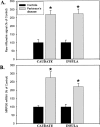Multiregional gene expression profiling identifies MRPS6 as a possible candidate gene for Parkinson's disease
- PMID: 17193926
- PMCID: PMC6032441
- DOI: 10.3727/000000006783991827
Multiregional gene expression profiling identifies MRPS6 as a possible candidate gene for Parkinson's disease
Abstract
Combining large-scale gene expression approaches and bioinformatics may provide insights into the molecular variability of biological processes underlying neurodegeneration. To identify novel candidate genes and mechanisms, we conducted a multiregional gene expression analysis in postmortem brain. Gene arrays were performed utilizing Affymetrix HG U133 Plus 2.0 gene chips. Brain specimens from 21 different brain regions were taken from Parkinson's disease (PD) (n = 22) and normal aged (n = 23) brain donors. The rationale for conducting a multiregional survey of gene expression changes was based on the assumption that if a gene is changed in more than one brain region, it may be a higher probability candidate gene compared to genes that are changed in a single region. Although no gene was significantly changed in all of the 21 brain regions surveyed, we identified 11 candidate genes whose pattern of expression was regulated in at least 18 out of 21 regions. The expression of a gene encoding the mitochondria ribosomal protein S6 (MRPS6) had the highest combined mean fold change and topped the list of regulated genes. The analysis revealed other genes related to apoptosis, cell signaling, and cell cycle that may be of importance to disease pathophysiology. High throughput gene expression is an emerging technology for molecular target discovery in neurological and psychiatric disorders. The top gene reported here is the nuclear encoded MRPS6, a building block of the human mitoribosome of the oxidative phosphorylation system (OXPHOS). Impairments in mitochondrial OXPHOS have been linked to the pathogenesis of PD.
Figures




Similar articles
-
Construction of Parkinson's disease marker-based weighted protein-protein interaction network for prioritization of co-expressed genes.Gene. 2019 May 20;697:67-77. doi: 10.1016/j.gene.2019.02.026. Epub 2019 Feb 16. Gene. 2019. PMID: 30776463
-
Expression profiling of substantia nigra in Parkinson disease, progressive supranuclear palsy, and frontotemporal dementia with parkinsonism.Arch Neurol. 2005 Jun;62(6):917-21. doi: 10.1001/archneur.62.6.917. Arch Neurol. 2005. PMID: 15956162
-
SRRM2, a potential blood biomarker revealing high alternative splicing in Parkinson's disease.PLoS One. 2010 Feb 8;5(2):e9104. doi: 10.1371/journal.pone.0009104. PLoS One. 2010. PMID: 20161708 Free PMC article.
-
[Etiology and pathogenesis of Parkinson's disease: from mitochondrial dysfunctions to familial Parkinson's disease].Rinsho Shinkeigaku. 2004 Apr-May;44(4-5):241-62. Rinsho Shinkeigaku. 2004. PMID: 15287506 Review. Japanese.
-
Gene expression profiling of sporadic Parkinson's disease substantia nigra pars compacta reveals impairment of ubiquitin-proteasome subunits, SKP1A, aldehyde dehydrogenase, and chaperone HSC-70.Ann N Y Acad Sci. 2005 Aug;1053:356-75. doi: 10.1196/annals.1344.031. Ann N Y Acad Sci. 2005. PMID: 16179542 Review.
Cited by
-
Netrin-1 and its receptor DCC modulate survival and death of dopamine neurons and Parkinson's disease features.EMBO J. 2021 Feb 1;40(3):e105537. doi: 10.15252/embj.2020105537. Epub 2020 Dec 22. EMBO J. 2021. PMID: 33351190 Free PMC article.
-
PGC-1α, a potential therapeutic target for early intervention in Parkinson's disease.Sci Transl Med. 2010 Oct 6;2(52):52ra73. doi: 10.1126/scitranslmed.3001059. Sci Transl Med. 2010. PMID: 20926834 Free PMC article.
-
Neuron-released oligomeric α-synuclein is an endogenous agonist of TLR2 for paracrine activation of microglia.Nat Commun. 2013;4:1562. doi: 10.1038/ncomms2534. Nat Commun. 2013. PMID: 23463005 Free PMC article.
-
Mean Expression of the X-Chromosome is Associated with Neuronal Density.Front Neurosci. 2012 Nov 12;6:161. doi: 10.3389/fnins.2012.00161. eCollection 2012. Front Neurosci. 2012. PMID: 23162423 Free PMC article.
-
Translational defects in a mutant deficient in YajL, the bacterial homolog of the parkinsonism-associated protein DJ-1.J Bacteriol. 2010 Dec;192(23):6302-6. doi: 10.1128/JB.01077-10. Epub 2010 Oct 1. J Bacteriol. 2010. PMID: 20889753 Free PMC article.
References
-
- Bernardi P.; Scorrano L.; Colonna R.; Petronilli V.; Di Lisa F. Mitochondria and cell death. Mechanistic aspects and methodological issues. Eur. J. Biochem. 264:687–701; 1999. - PubMed
-
- Blochl A.; Sirrenberg C. Neurotrophins stimulate the release of dopamine from rat mesencephalic neurons via Trk and p75Lntr receptors. J. Biol. Chem. 271:21100–21107; 1996. - PubMed
-
- Bonifati V.; Rizzu P.; van Baren M. J.; et al. Mutations in the DJ-1 gene associated with autosomal recessive early-onset parkinsonism. Science 299:256–259; 2003. - PubMed
Publication types
MeSH terms
Substances
LinkOut - more resources
Full Text Sources
Other Literature Sources
Medical
